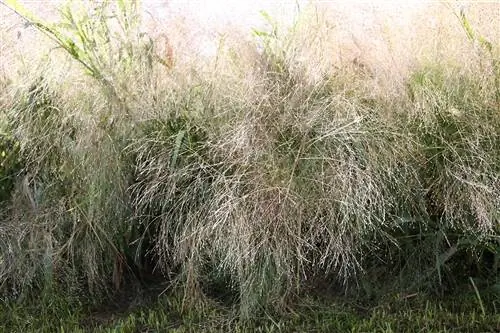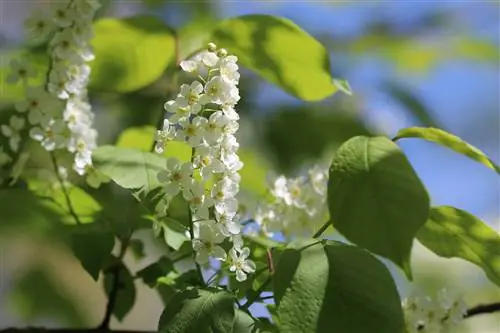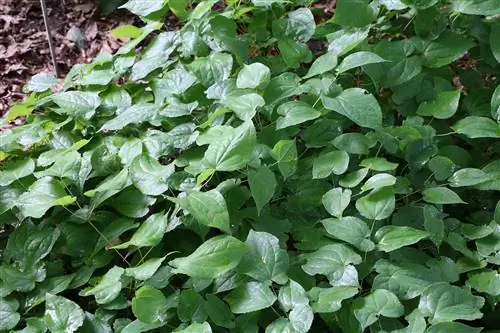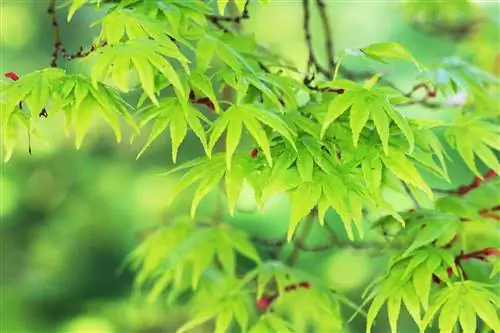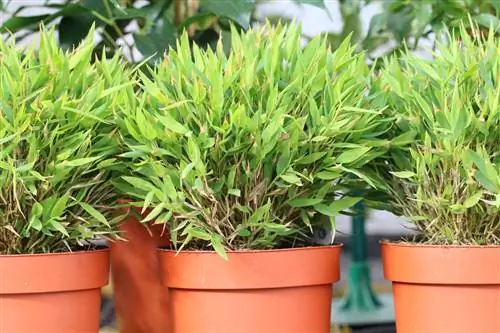- Author admin [email protected].
- Public 2023-12-17 03:39.
- Last modified 2025-01-24 12:45.
When the narrow stalks of switchgrass bend under the pretty flower spikes in late summer, the ornamental grass offers an attractive sight. You can read how to optimally plant and care for Panicum virgatum in our guide.
Profile
- Origin: North America
- Use: easy-care ornamental grass in different varieties and colors
- Growth height: between 60 centimeters and two meters
- Growth width: up to one meter
- Growth: clump-forming, upright
- Flowering: brown flower spikes between July and September
- Leaves: narrow, autumn colors
- Recommended varieties: 'Rehbraun' (red-brown in autumn), 'Hänse Herms' (bright red), 'Northwind' (yellow autumn color), 'Heavy Metal' (bluish), 'Strictum' (bright yellow)
Location and soil
It is best to plant the switchgrass in a full sun spot with loose, well-drained and humus-rich soil. Like all grasses, Panicum virgatum does not tolerate waterlogging, which is why heavy, loamy soil is unsuitable. However, you can improve this if necessary:
- Dig out at least 15 centimeters deep
- Create drainage from pebbles and sand
- fill with humus soil
Light sandy soils, on the other hand, should be enriched with nutrient-rich humus soil, as the grass has a high nutrient requirement. Partially shaded or sunny locations are too dark and therefore unsuitable; the plant will not produce flowers here.
Planting time
The best planting time is spring, as soon as the sun has developed sufficient strength and the ground has thawed. You can now plant the robust panicum from March onwards, although the soil should be kept slightly moist in the first few weeks after planting. If it is moist and warm enough, the switchgrass grows very quickly and develops many strong stalks. In principle, planting is possible throughout the summer until October.
Plants and plant spacing
And this is the best way to plant the uncomplicated switchgrass:
- Dig planting hole
- optimal size: twice as big as the root ball
- Loosen up the hole base well
- If necessary, fill in drainage (e.g. sand)
- Mix excavated material with mature compost
- alternatively good humus or purchased compost soil
- Insert plant
- not too deep: should be level with the ground just like in the planter
- Tread the earth
- water vigorously
The recommended planting distance for group planting is a distance of approx. 30 to 50 centimeters; for solitary planting you can leave a little more space between the clumps.
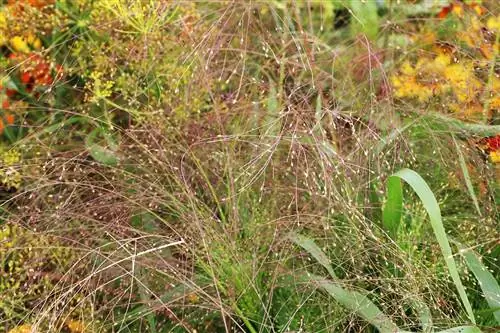
Tip:
Mulch the root area, for example with gravel or bark mulch. This not only prevents the soil from drying out, but also prevents annoying weeds from growing.
Pouring
When it comes to watering, Panicum virgatum is a bit tricky: Although an even supply of water is necessary, especially in the first few weeks after planting and during the hot and dry summer months, the roots must not be too wet.
- water regularly but moderately in the first two years after planting
- Just keep the soil slightly moist
- important for rooting and establishing at the new location
- Moisture ensures strong root growth
- in later years, only water on sunny, hot days or in very dry weather periods
Since the amount of watering depends on individual parameters such as location, soil conditions, temperature and size of the plant, no precise information can be given about the optimal amount of water. If in doubt, it is better to keep the clumps dry rather than moist, as switchgrass is much less sensitive to dryness. As long as the stalks appear vital, the plant is properly cared for. However, if Panicum leaves it hanging limply on a sunny day, you should check the soil moisture, for example using a finger test, and adjust your watering behavior.
Fertilize
Switchgrass planted in the garden is fertilized twice a year, for which organic fertilizers such as compost or a commercially available bamboo fertilizer are best suited. Alternatively, you can also use an organic garden fertilizer. The first fertilization takes place with the spring shoots and is intended to strengthen the plant for strong growth.
- one shovel full of ripe compost per horst
- distribute in the root area
- work lightly into the soil
- dose purchased fertilizer according to package instructions
- always water afterwards
The second fertilization takes place between mid-June and early July and has the task of replenishing depleted nutrient reserves and preparing the nest for the coming winter. In addition to the autumn color, flowering only occurs when there is a sufficient supply of nutrients.
Tip:
Homemade nettle manure, mixed in a ratio of 1:9 with rainwater and a handful of primary rock powder, produces a valuable liquid plant fertilizer.
Cutting
In autumn the stalks dry up, but should remain on the plant during the winter months as a natural protection against the cold. Only in early spring do you cut off last year's stalks close to the ground to make room for the new shoots. It is best to carry out this cut on a dry, frost-free day in March or April.
Wintering
Since Panicum virgatum is very hardy, you don't need to take any special precautions. Only for young plants that have been in their location for less than two years does light winter protection in the form of brushwood, leaves or compost make sense when it is very cold. You do not need to cover the dry stalks; instead, the cold protection is only applied to the root area. The layer should be about five centimeters thick.
Propagate
The simplest way of propagation is division, in which you get several smaller plants from a clump. The best way to do this is as follows:
- best time: spring
- cut dry stalks close to the ground
- Dig up the horst including the roots
- Use digging fork
- Divide the rootstock into several pieces with a spade
- Replant pieces individually
Tip:
You don't necessarily need to dig up very large clumps of grass; you can simply cut off the outer parts of these with a sharp spade and plant them in the garden as new plants.

Use and planting neighbors
Panicum looks good both alone and in a group planting. The taller varieties, for example 'Strictum' or 'Cloud Nine', are also very suitable as privacy screens, for example to separate the terrace from prying eyes. Otherwise, the grass harmonizes very well with late-flowering perennials that have similar location preferences. The switchgrass comes into its own particularly well with species such as
- Purple Coneflower (Echinacea purpurea)
- Penstemon barbatus
- Autumn asters (Aster dumosus)
- Phlox/ phlox (Phlox paniculata)
- Sedum/ Stonecrop (Sedum)
- Splendid charcoal (Liatris spicata)
- Candelabra Speedwell (Veronicastrum virginicum)
- Blue rue/ silver bush (Perovskia atriplicifolia)
It is also possible to associate with other grasses that thrive in dry, sunny places. Suitable for this are
- Blue oats (Helictotrichon sempervirens)
- Blue fescue (Festuca glauca)
- Rainbow fescue (Festuca amethystina)
- Whiskey grass (Molinia arundinacea)
- Pennisetum alopecuroides
- Heron feather grass (Stipa pulcherrima)
In addition to the plant species mentioned, colorful leafy trees such as the bladderwort (Physocarpus opulifolius) or the wig bush (Cotinus coggygria) also fit harmoniously into a bed with Panicum virgatum.
Tip:
A picturesque autumn bed is created from various grasses, autumn asters and sedum.
Bucket keeping
Lower Panicum varieties can be easily cultivated in pots, as long as there is good drainage in the planter. This should definitely have a drainage hole at the bottom and be placed in a planter or bowl so that excess water can be removed immediately. You should also add a two to five centimeter thick drainage layer made of pottery shards or expanded clay to the bottom of the pot, depending on the size of the pot. Only then is the loose, nutrient-rich humus or compost soil added.
In contrast to planted switchgrass, you should keep specimens cultivated in pots evenly moist and provide them with a slow-release fertilizer in spring. These care instructions also help:
- repot annually in fresh substrate
- If necessary, choose a larger pot
- preferably made of natural material such as ceramic or clay
- Avoid plastic due to heat generation
- wrap in jute or fleece in winter
- occasional watering even in winter
You can plant the switchgrass individually, but also together with other species in a larger container. Here you should definitely adhere to the recommended planting distance. Lower varieties such as 'Rehbraun', 'Hänse Herms' or 'Shenandoah' are ideal for keeping in containers.
Diseases and pests
The switchgrass is very robust and not very susceptible to pest infestation or diseases. Problems usually only arise because the wrong location was chosen or the plant was kept too moist. You can recognize the latter by the initially yellowing leaf tips, which later turn black and die. In locations that are too dark, however, no flowers and only a few new shoots form.

